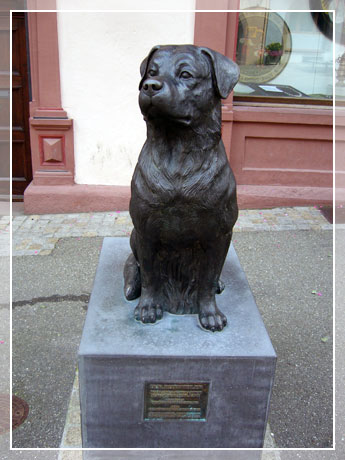|
The
Rottweiler, or Rottweil Metzgerhund (Butchers
Dog), is a "medium to large size, stalwart
dog" breed originating in Germany as a herding
dog. It is a hardy and very intelligent breed.
Rottweilers also worked as draught dogs, pulling
carts to carry meat and other products to market.
"Rottweiler breeders aim at a dog of abundant
strength, black coated with clearly defined rich tan
markings, whose powerful appearance does not lack
nobility and which is exceptionally well suited to
being a companion, service and working dog."
The
Rottweiler was kept busy in these traditional roles
until the mid-19th century when railroads replaced
droving for getting livestock to market. Although
there are still Rottweilers working stock all over
the world, many other roles have been found for this
versatile breed.
During
the first and second World Wars, Rottweilers were
put into service as guard dogs. Currently they are
often used as guard and police dogs in addition to
their traditional roles.
·
Description :
The
breed is always black with clearly defined tan or
mahogany markings above the eyes, on the cheeks,
muzzle, chest and legs. The coat is medium length
and consists of a waterproof undercoat and a coarse
top coat. Rottweiler coats tend to be low
maintenance, although they experience shedding
during their periods. The skull is typically
massive, but without excessive jowls.
·
Appearance :
Technically
a "medium / large" breed, according to the
FCI standard the Rottweiler stands 61 to 68 cm
(24-27 inches) at the withers for males, and 56 to
62.5 cm (22-25 inches) for females, and the average
weight is 50 kg (110 pounds) for males and 42 kg (93
pounds) for females.
·
Temperament :
According
to the FCI Standard, the typical Rottweiler is
"good natured, placid in basic disposition and
fond of children, very devoted, obedient, biddable
and eager to work. His appearance is natural and
rustic, his behaviour self assured, steady and
fearless. He reacts to his surroundings with great
alertness."
The
Rottweiller ranks 9th in Stanley Coren's The
Intelligence of Dogs, being one of the brightest 10
dogs ranked by obedience command trainability.
Rottweilers
are not recommended for people who have little
experience with dogs or understand little about dog
psychology and responsible canine ownership.
Obedience training and socialization are essential.
Rottweilers
are an extremely powerful breed with well developed
genetic guarding and herding instincts, and prey
drive. As with any breed, potentially dangerous
behaviour in Rottweilers results from irresponsible
ownership, abuse, neglect, or lack of socialization.
Because of their size, power and weight, an
aggressive Rottweiler can cause a higher level of
damage than a smaller, weaker dog. Injuries and
maulings may occur when an owner or passerby tries
to separate fighting dogs, or unintentionally
triggers a guarding behavior in a dog.
The
breed has received some negative publicity. In the
US, the Rottweiler is the number one breed of dog
named in fatal human attacks in 2000, in a report by
the CDC. These reports must be read in the context
of the breed's popularity as it was the most popular
breed in the United States in the same period.
The
portrayal of Rottweilers as evil dogs in several
fictional films and TV series, most notably in The
Omen, and sensationalist media hysteria has added to
their negative publicity. This hysteria has led to
Rottweilers being banned in some municipalities and
are sometimes targeted as dangerous dogs by
legislation, such as in the Netherlands and
Portugal. However, some films have portrayed the
gentler side of a Rottweiler's personality,
including Lethal Weapon 3 where a Rottweiler
guarding a gun smuggling operation is placated by
one of the main characters with dog treats, and
later rescued and de facto adopted.

Rottweiler
memorial in Rottweil, Germany
|